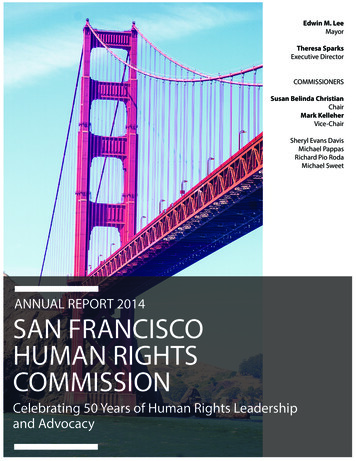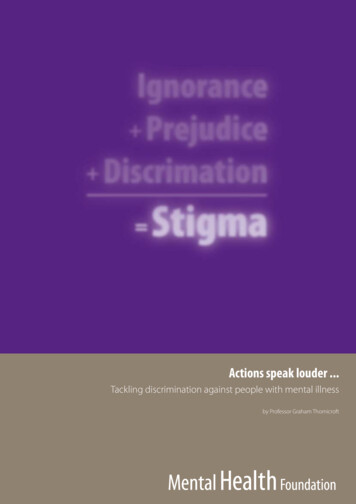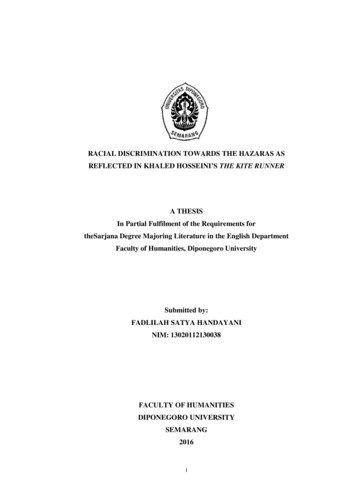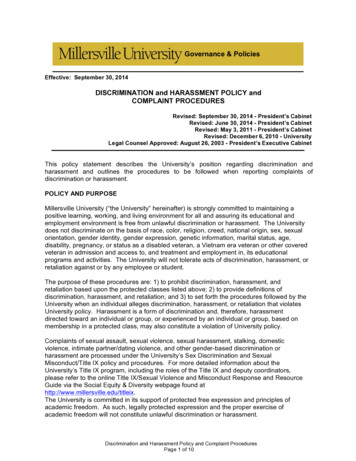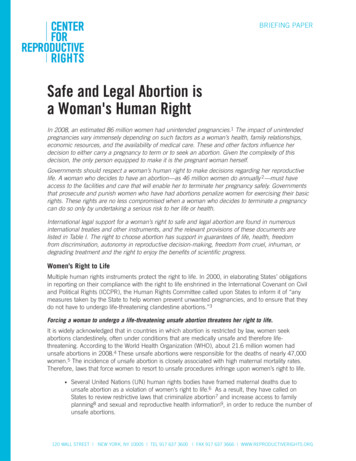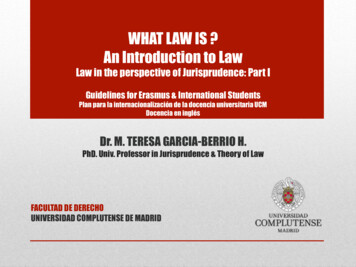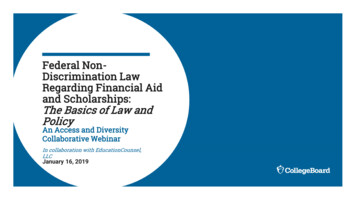
Transcription
Federal NonDiscrimination LawRegarding Financial Aidand Scholarships:The Basics of Law andPolicyAn Access and DiversityCollaborative WebinarIn collaboration with EducationCounsel,LLCJanuary 16, 2019
Introductions Wendell Hall, Moderator Senior Director, Higher Education, The College Board Art Coleman art.coleman@educationcounsel.com Managing Partner, EducationCounsel, LLC. Former U.S. Department of Education Deputy AssistantSecretary for Civil Rights Jamie Lewis Keith jamie.keith@educationcounsel.com Partner, EducationCounsel, LLC Former Primary Counsel, MIT; Vice-President, GeneralCounsel and Secretary, University of Florida2
DisclaimersLawyers just sayin’ConductItdepends.It’s aquestion ction(Nothing in this discussion constitutes institution-specific legal advice.)3
Webinar Overview & Major ThemesSectionsI. The Legal Landscape Pastand PresentMajor Themes1.Federal non-discrimination laws that govern admissions also govern aid.But, a dearth of precedent exists with respect to aid-specific policies andprograms advancing diversity-related aims.2.Major imperatives from admissions case law are likely consequentialregarding aid Mission and program alignment Definitional clarity Full inventory (including privately-endowed aid) Extension of holistic review principles where feasible Assurance of necessity/Examination of neutral alternatives3.When applying general non-discrimination rules, context matters. It mayhave an effect on legal analysis and conclusions. (Admissions is not aid.) Limited race-exclusive aid is higher risk; may be permissible ifevidence proves real necessity and lack of burden on non-beneficiaries Pooling funds in neutral fashion mitigates legal riskII. Kinds of Aid and ImplicationsIII. Strategies and Action StepsIV. Moving Forward4
I. The Legal Landscape Past and Present
Focus of Discussion: Federal LawEqual Protection Clause/ TitleVI Discrimination on the basisof race and ethnicityEqual Protection Clause/ TitleIX Discrimination on the basisof sex Emerging body of law toextend to discriminationbased on sexual orientationand gender identityNote: Many other factors are central to diversity interests, but federal law imposesheightened scrutiny (including requirements for evidence) when race, ethnicity,and sex are considerations.6
State Laws May BeRelevantVoter Initiatives/Executive Orders Resource:Beyond Federal Law: Trendsand Principles Associated withState Laws Banning theConsideration of Race,Ethnicity, and Sex AmongPublic Education Institutions(AAAS and EducationCounsel,2012)Source: Kahlenberg, R.D. 2014. The Future of Affirmative Action. (n.p.): Lumina Foundation and The CenturyFoundation, Inc. Available at: ve-action/7
Federal Non-Discrimination LawKey QuestionsA focus on ends andmeansCompelling/Important InterestsPolicy Design Specifically TailoredDesign to Advance InterestsNecessityEducational benefits ofdiversityConsideration/pursuit of neutralavenuesImpactFlexibilityMinimal adverse impact on nonbeneficiariesPeriodic review8
Federal Case Law No federal court precedent exists regarding diversity-focusedfinancial aid and scholarship decisions involving theconsideration of race and ethnicity. Podberesky v. Kirwan (1994) was a remedial case The U.S. Department of Education in 1994 issued notice andcomment Title VI policy guidance—governs USED OCRenforcement. Admissions cases are informative precedent Context matters; differences between aid and admissionmay result in different outcomes Still in effect, but untested in court Fisher v. University of Texas at Austin Aid policy not challenged, but UT’s neutral aid wasimportant foundation for court in upholding race-consciousadmissions policy--helping establish evidence that UTpursued all viable race-neutral/less race-restrictive9alternatives
1994 USED Title VIGuidance Recognition of the educational benefits of diversity as alegitimate compelling interest to support aid/scholarshipdecisions Presumption of narrow tailoring for race-as-a-factor aid,where periodic review and evaluation is evident A point on which courts might differ Allowance of race-exclusive aid where all narrow tailoringfactors can be satisfied Untested in court. Court adoption would depend on makingthe case about critical differences in aid and admission; andlikely showing that exclusive aid was a small portion of thetotal aid offered10
Other USED Federal Policy Federal Regulations OCR Case Resolutions re Aid Other OCR Action11
Reported OCR Investigations of NoteAlleged sex discrimination in aid, mentoring,community building, and other programs Yale University University of Southern California12
II. Kinds of Aid and Implications
Types andSources of AidThe Big Picture Mission Alignment Program Alignment andCoherence Where factors of race, ethnicity, and gender arepresent in aid design, federal non-discriminationlaw is likely to insist on a coherent, aligned set ofpolicies and programs that reflect: Mission Alignment Program Alignment To establish that important foundation, IHEsshould have a clear aid strategy thatencompasses all facets of aid controlled by theinstitution. Enrollment management has real meaning here.See Fisher v. UT.14
Policy Coherenceand AlignmentKey Questions1. Does the institution have a comprehensiveinventory of all policies and programsassociated with student outreach, recruitment,admission and aid?2. Do the philosophy and aims of the institution’sadmission policy extend into policiesassociated with student outreach, recruitment,and aid? Is there fundamental alignmentacross sectors?3. Where applicable, can the institutiondemonstrate both the need for and positiveimpact associated with considerations of raceand ethnicity as part of any facet of enrollmentpractice? What evidence exists that neutralstrategies or lesser use of race is inadequate?15
Types andSources of AidKey Factors Informingthe Program Overviewand Levels of InquiryKey Point: Thiscategory is pure-needbased race,ethnicity, and genderblind.Key Questions: How ismerit defined? Is itinclusive of diversity factorsthat raise legal issues?Need-BasedMerit-BasedMixed NeedMeritGovernmentFundedNo central issue.Importantcontext.Point of focus,depending ondefinitions.Point of focus,depending ondefinitions.InstitutionFundedNo central issue.Importantcontext.Point of focus,depending ondefinitions.Point of focus,depending ondefinitions.PrivatelyEndowedNo central issue.Importantcontext.Point of focus,depending ondefinitions.Point of focus,depending ondefinitions.16
DefinitionsKey Questions What do we mean by aid? What is included?Just funding associated with tuition and cost ofliving, or more: enrichment programs, etc.? How do we define merit? What factors shapedeterminations of “merit” in aid -- and, byextension, other enrollment efforts? Are race,ethnicity, and gender relevant to thosedeterminations? How do we define diversity? How does your IHEdefine diversity—and why? What set of factorsare relevant to your enrollment focus on diversity,and how do these extend to aid decisions, inparticular?17
III. Strategies and Action Steps
Strategies andAction StepsThe Big Picture Full Inventory Determination ofnecessity/examination & pursuit ofneutral avenues Rare, limited use of race-exclusiveaid Pooling of funds Extension of holistic reviewprinciples where feasible Process managementAs a foundation for effective analysis and decisionmaking, an initial process step involves thefollowing:Fully inventory all aid policies, practices andprograms, to establish a comprehensive overviewof all kinds of institutional aid from all sources. All types of aid, regardless of whetherconsiderations of race, ethnicity, gender arepresent All sources, with a particular focus on institutionfunded, as well as privately endowed aid Does the IHE engage in “significant assistance” in theadministration of private aid? If so, essential to includethat aid in inventory and analysis.19
Strategies andAction StepsThe Big Picture Full Inventory Determination ofnecessity/examination &pursuit of neutral avenues Rare, limited use of race-exclusiveaid Pooling of funds Extension of holistic reviewprinciples where feasible Process managementWithin that overall inventory, identify and segregatefor focused analysis all aid that involves anyconsideration of an individual’s race, ethnicityand/or gender. With respect to such aid:Assure that you have undertaken an evaluation ofthe necessity of consideration of those factors withrespect to achievement of institutional diversitygoals. Are relevant policy designs that involve suchconsiderations necessary—at all or with as muchconsideration of race, ethnicity, gender? Have all viable neutral alternatives been considered and,where appropriate, tried? Have you documented with evidence the judgments youhave made (decisions, rationales, data, etc.) and theprocesses that led to those judgments?20
Strategies andAction StepsThe Big Picture Full Inventory Determination ofnecessity/examination & pursuit ofneutral avenues Rare, limited use of raceexclusive aid Pooling of funds Extension of holistic reviewprinciples where feasible Process managementWithin that overall inventory, and in the contextoutlined above:Segregate and separately evaluate any aid that mayqualify as race-, ethnicity-, or gender-exclusive.Remember that such aid practices, while allowedunder current USED policy, have not been tested incourt. Very high bar here. Questions of necessity of exclusive aid (vs. e.g., as-a-factoraid and neutral aid) and burden on non-beneficiaries areparamount. Can you make the case? Critical to evaluate what portion of total aid budgetexclusive aid represents if it is to be sustained under USEDpolicy. (E.g., Very small % of total aid awarded; additive.)21
Race-ExclusiveAid, IllustratedTotal AidExclusiveAid22
Strategies andAction StepsThe Big Picture Full Inventory Determination ofnecessity/Examination & pursuit ofneutral avenues Rare, limited use of race-exclusiveaid Pooling of funds Extension of holistic reviewprinciples where feasible Process managementOne strategy for mitigating legal risk involves poolingof funds.Pooling means the placement of each individualdonor gift in the same general scholarship pool withall other comparable aid. When making awards tostudents, the institution decides who gets aid, howmuch and what kind (grant, work study) completelyblind to race, ethnicity and gender—but then matchesindividual students with awards—and strives to do soin a way that aligns with the preferences of theoriginal donor. Not tested in court, but removes considerationof race, ethnicity, and gender from actual awarddecision, while honoring donor wishes that mayinclude such considerations.23
Pooling, Illustrated Source:A Federal Legal and Policy Primer onScholarships: Key Non-discriminationPrinciples and Actionable Strategies forInstitutions of Higher Education andPrivate Scholarship Providers(National Scholarship ProvidersAssociation, College Board,EducationCounsel, 2016, available dual donor giftsPool of all donated fundsIndividual student awards24
Strategies andAction StepsThe Big Picture Full Inventory Determination ofnecessity/examination & pursuit ofneutral avenues Rare, limited use of race-exclusiveaid Pooling of funds Extension of holistic reviewprinciples where feasible In light of dearth of specifically applicable caselaw, and in line with aims for enrollment policycoherence, it is prudent to consider extension ofadmission principles that courts have affirmed.Consider: Models of aid that reflect consideration ofmultiple, intersecting factors associated withdiversity (including but not limited toconsiderations involving race, etc.) Tiering of top admission candidates (based onmultiple factors associated with holistic review)as a foundation for making aid awardsProcess management25
Strategies andAction StepsThe Big Picture Full Inventory Determination ofnecessity/Examination & pursuit ofneutral avenues Rare, limited use of race-exclusiveaid Pooling of funds Extension of holistic reviewprinciples where feasible Process managementTeamMultidisciplinaryAll facets of institution coveredGoals and ObjectivesClarity on educational goals and objectivesFoundations upon which success can be evaluatedDesignIntegral part of overall enrollment management strategyNecessity re consideration of race, ethnicity, sex (including neutral/lessrestrictive alternatives)Limited burden/adverse impact on non-qualifying studentsExtension of holistic review principles where possibleProcess ManagementPeriodic review and evaluation of relevant policies, practices, and impact,including:EffectivenessContinuing need for consideration of race, ethnicity, genderNeutral strategies pursued and rejected (and why)EvidenceInventory all relevant policies/practices and programsDocument decision making and assemble evidence26
IV. Moving Forward
New ADC Publication:Early 2019Federal Non-Discrimination Law: Implications for HigherEducation Financial Aid and Scholarship Policies and ProgramsWill provide undergraduate enrollment officials with practical,actionable guidance regarding the design and execution offinancial aid and scholarship policies that advance diversity goals.It will: Identify key issues that should be considered in the review,evaluation, and evolution of financial aid and scholarshippolicies and practices associated with diversity goals; Synthesize key points of law and policy in a format designed tofacilitate meaningful on-the-ground dialogue and action; and Offer ideas regarding strategies and models that meritconsideration among policy leaders as they seek to achieveinstitutional diversity goals in legally sustainable ways.28
Access & DiversityCollaborativeWho We Are & WhatWe Do Established in 2004, the College Board's Access & DiversityCollaborative (ADC) provides national leadership andinstitutional support focused on higher education diversitygoals. The ADC serves as: A voice of national advocacy, A resource for sophisticated and pragmatic policy andpractice guidance and actionable research, and A convener for thought leadership and collaborativeengagement on policy and practice development. Over 50 institutions of higher education and 13 nationalorganizational sponsor the ADC, which relies heavily on thesupport and guidance of its sponsors to identify key “on theground” issues to address, and make recommendationsregarding strategic directions. For more information on the ADC and on sponsorship, pleasevisit www.collegeboard.org/accessanddiversity or emailaccessanddiversity@collegeboard.org.29
Key ResourcesNewHolisticReviewEvidenceUnderstanding HolisticReview in Higher EducationAdmissions(College Board,EducationCounsel, 2018)Building an Evidence Base(College Board, 2017)NeutralAvenuesKeyResourcesThe PlaybookRe Neutral Alternatives(College Board,EducationCounsel, 2016)A Policy and Legal "Syllabus"for Diversity Programs atColleges and Universities(ACE, College Board,EducationCounsel, 2015)30
Questions31
Thank you!Wendell Hall whall@collegeboard.orgArt Coleman art.coleman@educationcounsel.comJamie Lewis Keith jamie.keith@educationcounsel.com32
Questions of necessity of exclusive aid (vs. e.g., as-a-factor aid and neutral aid) and burden on non-beneficiaries are paramount. Can you make the case? Critical to evaluate what portion of total aid budget exclusive aid represents if it is to be sustained under USED policy. (E.g., Very small % of total aid awarded; additive.) 21
